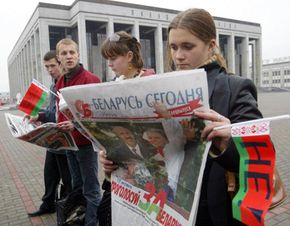In 1999, the secretive paramilitary organization, Delta Force, was deployed to Seattle, Wash. to quell protest at the World Trade Organization's summit. The police and the National Guard had their hands full with protestors who displayed the uncanny ability to work as a group. The dissenters, in what came to be known as the "Battle for Seattle," were linked together via wireless devices like cell phones and text messaging that allowed the group to work as a whole -- and to respond to warnings that the authorities were advancing. The Seattle protestors in 1999 were among the world's first smart mobs, so named because each person in the group uses technology to receive information on where to go and what to do. This ability to stay on top of current events makes smart mobs extremely effective.
Modern protests like this one inspired author and futurist Howard Rheingold to coin the term smart mob. Rheingold traveled around the world studying this behavior and realized that what he witnessed was the emergence of a new kind of civil disobedience, one in which mobs use the very technology used against them to their advantage. This is called sousveillance -- watching from below [source: Steffen]. This type of observation uses readily available technology like handheld camcorders to turn the lens on those who normally are the ones watching. The bystander filming the beating of motorist Rodney King by the Los Angeles Police Department in 1991 is an example of sousveillance.
Advertisement
In Rheingold's book, "Smart Mobs: The Next Social Revolution," the author concluded that the survival of protest in the 21st century depended on shrewdly employed technology. Fortunately for protestors, the 21st century has affordable consumer electronics in aces. Applications like Twitter, weblogs and the social structure that's given rise to Web 2.0 all aid in the quick disbursal of information from one source to many. Thanks to things like open source coding, net neutrality and hackers, technology has become "democratized" -- the public constantly finds and shares new ways to use technology.
It is this democratization of technology that set the stage for the development of smart mobs. Find out more about these groups on the next page.
Advertisement


